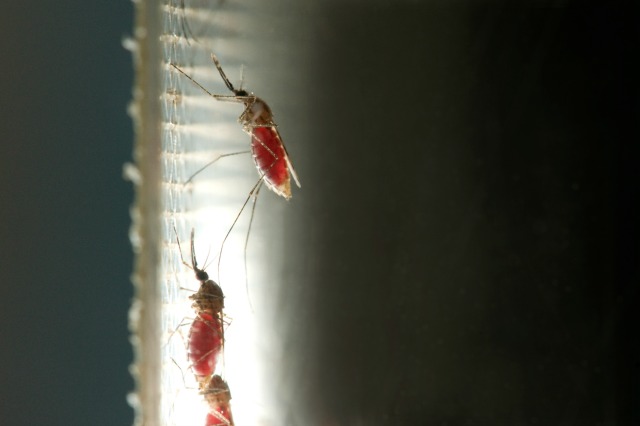-
 Mosquitos engorged with blood. Photo: Frank Muller
Mosquitos engorged with blood. Photo: Frank Muller
Every year, more than half a million people die from malaria, including many young children. Yet, there are still many questions surrounding the disease. Nijmegen molecular biologist Richard Bartfai, along with colleagues from Amsterdam UMC and the primate research institute BPRC, is researching one of these black holes: a malaria-causing dormant parasite.
When a malaria mosquito bites a human, parasites infiltrate the body. The dormant parasites hide in the liver, in an inaccessible and hitherto unknown location. This dormant parasite – called a hypnozoite – can be compared to a group of enemy soldiers hiding underground on your own territory.

If an infected patient goes to the doctor with symptoms, they are given medication. The active parasites are killed by the medication, but the dormant parasites don’t move and stay quiet as a mouse. The patient goes home and, after a few weeks or months, experiences symptoms again: the parasites are no longer dormant but have reactivated and are engaged in a devastating march through the body.
‘It’s fascinating in and of itself,’ states molecular biologist Richard Bartfai. ‘While in a dormant state, the parasites hardly do anything: their metabolism is slowed, they don’t divide, and they are barely recognizable. And then suddenly, they activate themselves,’ as explained by the Hungarian scientist from Radboud University.
Bartfai wants to understand how the parasites penetrate the ‘dormitories’ in the liver, where they are located, how they enter this dormant state, and what triggers reactivation. ‘With this knowledge, hopefully, we can develop a medicine that can tackle these parasites.’
The dormant variant
Not every malaria parasite can lie dormant. The dormant parasites are most common in Asia and South America, while the African variant cannot go to sleep. A parasite is much closer to humans than a bacterium or virus, making it difficult to find a good treatment method. ‘Developing medicines isn’t straightforward because the processes occurring in the body partly resemble those of the parasite. In other words, what’s dangerous for a parasite is often also dangerous for humans.’
Despite extensive global research, the disease still exists. Radboud researcher Richard Bartfai hopes that his research contributes to the eradication of malaria. The research team received a massive grant of 11 million euros from the European Research Council (ERC). ‘I was absolutely thrilled because this enables us to conduct a very complex study.’
‘The problem with these parasites is that they only nest in humans and apes.’
The research conducted by Radboud University, Amsterdam UMC, and BPRC is also very expensive, he explains. It is so complex individual research groups or institutes could never manage it. ‘And the research itself largely consists of experimental, costly components. We use apes and advanced technologies that allow us to assess the value of our results accurately,’ says the associate professor of molecular biology, who started in Nijmegen fifteen years ago as a postdoc.
At the BPRC research center in Rijswijk, the apes are infected with malaria. It’s a method that Bartfai ‘intensely dislikes but is also necessary,’ he says. ‘The problem with these parasites is that they only nest in humans and apes. So, we have no choice.’
Infected ape cell
Amsterdam UMC will develop advanced imaging technologies capable of visualizing and tracking the parasites in the liver. Once the researchers know where the parasites are located, tissue will be extracted for analysis. This biopsy will be examined in a lab, using advanced molecular technology that provides a comprehensive view of the processes occurring in the infected ape cell. ‘This will help us understand how infected cells differ from non-infected cells. This research phase could help us identify the trigger that activates the parasites.’
‘Without the most comprehensive picture possible, it’s difficult to devise a strategy and develop medicines.’
According to the World Health Organization (WHO), 619.000 people died from malaria worldwide in 2021. There were nearly 250 million cases that year, and half of the world’s population was at risk of contracting the disease. ‘Babies, children under five years old, pregnant women, travelers, and people with HIV or AIDS are at greater risk of severe infections,’ as stated by the WHO.
It’s not difficult to understand where Bartfai derives his motivation. ‘Without knowledge, without the most comprehensive picture, it’s difficult to continue research, devise a strategy, and develop medicines. This is crucial to stop this form of malaria.’
Translated by Siri Joustra



